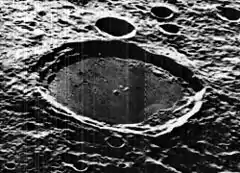Maksutov (crater)
Maksutov is a crater on the far side of the Moon. It is located just to the south-southwest of the larger walled plain Oppenheimer. To the southwest lies the crater Nishina, and to the west-northwest is the merged crater pairing of Davisson and Leibnitz.
 Clementine mosaic | |
| Coordinates | 40.5°S 168.7°W |
|---|---|
| Diameter | 83 km |
| Depth | 3270 m[1] |
| Colongitude | 170° at sunrise |
| Eponym | Dmitri D. Maksutov |

This crater has a reasonably well-defined outer rim that has not been significantly degraded through impact erosion. The more notable feature of this crater, however, is the flooded interior floor. This nearly level interior surface has the lower albedo that is characteristic of a basaltic-lava-covered floor. The inner wall of the rim varies in width, with the narrowest portion lying in the southeast, while wider sections lie along the remaining edges, particularly to the northeast and northwest. The depth of the crater here is defined as the distance between the highest point on the rim to the lowest area of the crater floor, not including the floor's impact craters.
Prior to formal naming in 1970 by the IAU,[2] the crater was known as Crater 439.[3]
Satellite craters
By convention these features are identified on lunar maps by placing the letter on the side of the crater midpoint that is closest to Maksutov.
| Maksutov | Latitude | Longitude | Diameter |
|---|---|---|---|
| U | 40.1° S | 170.9° W | 21 km |
References
- "LROC QuickMap". quickmap.lroc.asu.edu. Retrieved 2020-12-08.
- Maksutov, Gazetteer of Planetary Nomenclature, International Astronomical Union (IAU) Working Group for Planetary System Nomenclature (WGPSN)
- Lunar Farside Chart (LFC-1A)
- Andersson, L. E.; Whitaker, E. A. (1982). NASA Catalogue of Lunar Nomenclature. NASA RP-1097.CS1 maint: ref=harv (link)
- Blue, Jennifer (July 25, 2007). "Gazetteer of Planetary Nomenclature". USGS. Retrieved 2007-08-05.CS1 maint: ref=harv (link)
- Bussey, B.; Spudis, P. (2004). The Clementine Atlas of the Moon. New York: Cambridge University Press. ISBN 978-0-521-81528-4.CS1 maint: ref=harv (link)
- Cocks, Elijah E.; Cocks, Josiah C. (1995). Who's Who on the Moon: A Biographical Dictionary of Lunar Nomenclature. Tudor Publishers. ISBN 978-0-936389-27-1.CS1 maint: ref=harv (link)
- McDowell, Jonathan (July 15, 2007). "Lunar Nomenclature". Jonathan's Space Report. Retrieved 2007-10-24.CS1 maint: ref=harv (link)
- Menzel, D. H.; Minnaert, M.; Levin, B.; Dollfus, A.; Bell, B. (1971). "Report on Lunar Nomenclature by the Working Group of Commission 17 of the IAU". Space Science Reviews. 12 (2): 136–186. Bibcode:1971SSRv...12..136M. doi:10.1007/BF00171763.CS1 maint: ref=harv (link)
- Moore, Patrick (2001). On the Moon. Sterling Publishing Co. ISBN 978-0-304-35469-6.CS1 maint: ref=harv (link)
- Price, Fred W. (1988). The Moon Observer's Handbook. Cambridge University Press. ISBN 978-0-521-33500-3.CS1 maint: ref=harv (link)
- Rükl, Antonín (1990). Atlas of the Moon. Kalmbach Books. ISBN 978-0-913135-17-4.CS1 maint: ref=harv (link)
- Webb, Rev. T. W. (1962). Celestial Objects for Common Telescopes (6th revised ed.). Dover. ISBN 978-0-486-20917-3.CS1 maint: ref=harv (link)
- Whitaker, Ewen A. (1999). Mapping and Naming the Moon. Cambridge University Press. ISBN 978-0-521-62248-6.CS1 maint: ref=harv (link)
- Wlasuk, Peter T. (2000). Observing the Moon. Springer. ISBN 978-1-85233-193-1.CS1 maint: ref=harv (link)
- "LROC::QuickMap". Arizona State University. Retrieved 2020-12-07.CS1 maint: ref=harv (link)